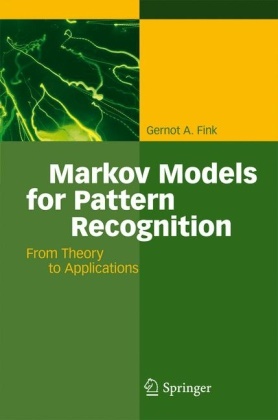Share
Gernot A. Fink
Markov Models for Pattern Recognition - From Theory to Applications
English · Hardback
Description
This comprehensive introduction to the Markov modeling framework describes the underlying theoretical concepts of Markov models as used for sequential data, covering Hidden Markov models and Markov chain models. It also presents the techniques necessary to build successful systems for practical applications. In addition, the book demonstrates the actual use of the technology in the three main application areas of pattern recognition methods based on Markov-Models: speech recognition, handwriting recognition, and biological sequence analysis. The book is suitable for experts as well as for practitioners. Markov models are used to solve challenging pattern recognition problemson the basis of sequential data as, e.g., automatic speech or handwritingrecognition. This comprehensive introduction to the Markov modeling frameworkdescribes both the underlying theoretical concepts of Markov models - coveringHidden Markov models and Markov chain models - as used for sequential data andpresents the techniques necessary to build successful systems for practicalapplications.
This comprehensive introduction to the Markov modeling framework describes the underlying theoretical concepts - covering Hidden Markov models and Markov chain models - and presents the techniques and algorithmic solutions essential to creating real world applications. The actual use of Markov models in their three main application areas - namely speech recognition, handwriting recognition, and biological sequence analysis - is presented with examples of successful systems.
Encompassing both Markov model theory and practise, this book addresses the needs of practitioners and researchers from the field of pattern recognition as well as graduate students with a related major field of study.
List of contents
1. Introduction
1.1 Thematic Context
1.2 Capabilities of Markov Models
1.3 Goal and Structure
2. Application Areas
2.1 Speech
2.2 Handwriting
2.3 Biological Sequences
2.4 Outlook
Part I: Theory
3. Foundations of Mathematical Statistics
3.1 Experiment, Event, and Probability
3.2 Random Variables and Probability Distributions
3.3 Parameters of Probability Distributions
3.4 Normal Distributions and Mixture Density Models
3.5 Stochastic Processes and Markov Chains
3.6 Principles of Parameter Estimation
3.7 Bibliographical Remarks
4. Vector Quantisation
4.1 Definition
4.2 Optimality
4.3 Algorithms for Vector Quantiser Design (LLoyd, LBG, k-means)
4.4 Estimation of Mixture Density Models
4.5 Bibliographical Remarks
5. Hidden-Markov Models
5.1 Definition
5.2 Modeling of Output Distributions
5.3 Use-Cases
5.4 Notation
5.5 Scoring (Forward algorithm)
5.6 Decoding (Viterbi algorithm)
5.7 Parameter Estimation (Forward-backward algorithm, Baum-Welch, Viterbi, and segmental k-means training)
5.8 Model Variants
5.9 Bibliographical Remarks
6. n-Gram Models
6.1 Definition
6.2 Use-Cases
6.3 Notation
6.4 Scoring
6.5 Parameter Estimation (discounting, interpolation and backing-off)
6.6 Model Variants (categorial models, long-distance dependencies)
6.7 Bibliographical Remarks
Part II: Practical Aspects
7. Computations with Probabilities
7.1 Logarithmic Probability Representation
7.2 Flooring of Probabilities
7.3 Codebook Evaluation in Tied-Mixture Models
7.4 Likelihood Ratios
8. Configuration of Hidden-Markov Models
8.1 Model Topologies
8.2 Sub-Model Units
8.3 Compound Models
8.4 Profile-HMMs
8.5 Modelling of Output Probability Densities
9. Robust Parameter Estimation
9.1 Optimization of Feature Representations (Principle component analysis, whitening, linear discriminant analysis)
9.2 Tying (of model parameters, especially: mixture tying)
9.3 Parameter Initialization
10. Efficient Model Evaluation
10.1 Efficient Decoding of Mixture Densities
10.2 Beam Search
10.3 Efficient Parameter Estimation (forward-backward pruning, segmental Baum-Welch, training of model hierarchies)
10.4 Tree-based Model Representations
11. Model Adaptation
11.1 Foundations of Adaptation
11.2 Adaptation of Hidden-Markov Models (Maximum-likelihood linear regression)
11.3 Adaptation of n-Gram Models (cache models, dialog-step dependent models, topic-based language models)
12. Integrated Search
12.1 HMM Networks
12.2 Multi-pass Search Strategies
12.3 Search-Space Copies (context and time-based tree copying strategies, language model look-ahead)
12.4 Time-synchronous Integrated Decoding
Part III: Putting it All Together
13. Speech Recognition
13.1 Application-Specific Processing (feature extraction, vocal tract length normalization, ...)
13.2 Systems (e.g. BBN Byblos, SPHINX III, ...)
14. Text Recognition
14.1 Application-Specific Processing (linearization of data representation for off-line applications, preprocessing, normalization, feature extraction)
14.2 Systems for On-line Handwriting Recognition
14.3 Systems for Off-line Handwriting Recognition
15. Analysis of Biological Sequences
15.1 Representation of Biological Sequences
15.2 Systems (HMMer, SAM, Meta-MEME)
Product details
| Authors | Gernot A. Fink |
| Publisher | Springer, Berlin |
| Original title | Mustererkennung mit Markov-Modellen |
| Languages | English |
| Product format | Hardback |
| Released | 01.01.2007 |
| EAN | 9783540717669 |
| ISBN | 978-3-540-71766-9 |
| No. of pages | 248 |
| Weight | 588 g |
| Illustrations | 51 SW-Abb., |
| Subject |
Natural sciences, medicine, IT, technology
> IT, data processing
> IT
|
Customer reviews
No reviews have been written for this item yet. Write the first review and be helpful to other users when they decide on a purchase.
Write a review
Thumbs up or thumbs down? Write your own review.

